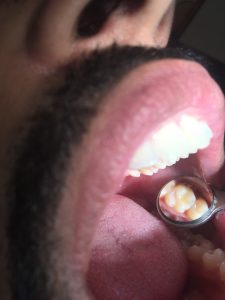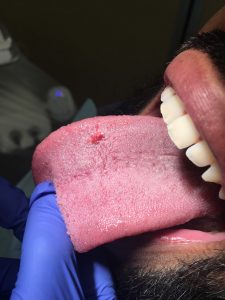Case I – Arestin
M.Z. 39 yr old male H/II
The patient had generalized red, bulbous, spongy and non-stippled gingiva with generalized 1-4mm probing depths and localized 5-6mm in posterior and localized recession. The 5-6mm can be supported by the bitewing radiograph findings. The patient has generalized periodontitis due to bone loss.
I taught the patient both brushing and flossing. The patient reports he brushes with a lot of force because he has a heavy hand. He also had a hard bristled toothbrush. He was carrying his toothbrush on him, so I made him throw it away in front of me and replaced it with a soft bristle toothbrush. I taught him the bass method of toothbrushing, which he then successfully demonstrated. He seemed like he had grasped the hang of it. During visit two, I taught him flossing. He was much more comfortable flossing than he was brushing. I asked him if he was interested in buying an electric toothbrush because it will light up red whenever he brushes too hard and he said he has one but has never taken it out the box. I explained to him that he will benefit from a brush that tells him he is brushing too hard since he had recession. He stated he understood the relationship between brushing hard and recession and during visit two he reported he had started using it and found it very useful.
V1: After completing the patient’s assessments, I took his plaque score, which was 0.5. I decided to teach him brushing during the first visit because he reported he brushes with a lot of force and with a hard bristle toothbrush. Then, I ultrasonic and hand-scaled the UR. He is very sensitive to pain so I had administered Oraquix. He responded very well, minimum to no pain.
V2: After reviewing the medical history and previously scaled areas, I exposed the patient to 4 BW radiographs. The patient was informed of calculus and bone loss and was made aware he has periodontal disease. I reviewed flossing with him and stressed the importance of flossing to help prevent further bone loss from occurring. I then ultrasonic and hand-scaled the UL and LL. Since he was in a lot of pain during the last visit, the patient was given 3 carpules of Lidocaine HCL 2% 1 carpule 100,000.
V3: After reviewing the medical history and previously scaled areas, the patient was exposed to a PAN to have BW radiographs and PAN to support the areas of Arestin placement. Arestin was placed in 2ML, 3DL, 3ML, 14DB, 15MB, and 20DB. We reviewed the post-op instructions. I advised the patient how important it was to follow up for Arestin evaluation 6 weeks after placement so we can assess the effects of the Arestin.
V4: After reviewing the medical history and previously scaled areas, I reviewed brushing once again to ensure patient understood the importance of lightly brushing. Next, I took an alginate impression on the patient. Then, I ultrasonic and hand-scaled the LR, polished and applied fluoride.
The patient never returned for Arestin evaluation.
Case II
M.C, 71 year-old female, M/II
The patient was taking Humalog and Lanthus for Diabetes type II and Synthroid for thyroid. She experienced severe xerostomia due to her medications. The patient had generalized pink, spongy rolled margins, 4-5mm probing depths with minimal bleeding upon probing and scaling. She had generalized subgingival calculus buildup and staining due to wine and coffee.
She had limitations opening her mouth. Using a bite block was not helpful because the bite block did not fit into her mouth. Because of this limitation, it was difficult to ultrasonic and hand scale. She has trouble brushing and flossing. An electric flosser and floss reacher were recommended and bought. She bought both aids during her appointment and proper instructions on how to use them were given. The patient reported flossing with both aids. The electric flosser was easy to reach anteriorly and the floss reacher was easy to reach posteriorly. They were very helpful because she had a lot of trouble getting floss in. I also recommended Biotene for her xerostomia. During the second visit, the patient reported she felt a difference regarding the dryness she felt.
V1: After updating assessments, I reviewed modified bass method of toothbrushing. Since the patient is a recare, she was familiar and correctly demonstrated the correct method of brushing. Since it was difficult for the patient to open her mouth, we split the appointment into two visits. I ultrasonic and hand-scaled the UR and LR.
V2: During the second visit, she bought in her electric flosser and floss reacher in. We reviewed and modified both devices to ensure she was flossing and reach every surface. I ultrasonic and hand-scaled the LR and LL. I then polished with fine grit and pumice to remove the staining. The patient refused fluoride.
Case III
S.S, 22 year-old male, M/II.
The patient had generalized pink, knife-edge gingiva with rolled margins. He had generalized 1-4mm probing depths with localized 5mm. Exposed FMS confirmed localized bone loss. There was moderate bleeding upon probing and exploring.
The patient presents with a papilloma on his tongue. He reports he has had it since birth and it does not bother him. A referral was given to an oral pathologist to have it removed.
V1: After updating assessments, I reviewed C-shaped method of flossing with the patient due to generalized subgingival calculus. I then ultrasonic and hand-scaled all four quadrants of the mouth. Polished with fine grit paste, flossed and applied fluoride varnish.
V2: The patient returned for 3 rubber-dam sealants.






